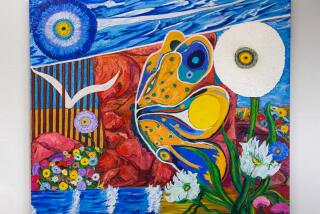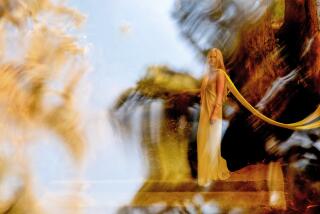Journey to Self-Discovery in a Land of Danger and Dreams
THE PIANO TUNER
A Novel
By Daniel Mason
Alfred A. Knopf
326 pages, $24
Burmese legend tells of the spirit, leip-bya, that flies at night outfitted with the wings of a butterfly, according to a character in “The Piano Tuner,” the luminous, dreamscape first novel by medical student Daniel Mason.
“When a man sleeps, the leip-bya flies from his mouth and goes about here and there, and sees things on its journey, and these are dreams,” Mason’s character explains. “The leip-bya must always return to a man by morning. This is why the Burmese don’t want to wake sleeping people. Perhaps the leip-bya is very far away, and it cannot return home fast enough.”
Told with the competence of a seasoned storyteller in almost old-fashioned prose, “The Piano Tuner” begins in 1886 London when Edgar Drake, a quiet, keep-to-himself piano tuner with a great love for Erard pianos, is summoned by the British War Office. In service to the Crown, Drake is told, is one Surgeon-Major Anthony Carroll, currently holding a provisional peace in the southern Shan States of war-torn Burma. Some months earlier, the surgeon-major had requested a rare 1840 Erard grand piano be delivered to the compound.
The military is highly suspicious of the eccentric doctor-soldier’s methods but is nonetheless convinced of his success in keeping the peace. Though greeted with derision, his piano requisition--really an ultimatum, Drake learns--was filled in order to keep the good doctor happy enough to continue providing his valuable services. (Carroll soothes the local warlords with poetry, medical care and music, thereby earning their trust and cooperation.)
Once the piano arrived, though, it was painfully out of tune and damaged from the arduous journey via elephant. Thus, the doctor requires the services of an Erard expert, which is where Drake comes in. “It’s much easier to deliver a man than a piano,” Carroll has written in his request.
Drake agrees to journey to Burma--a three-month expedition in service to his nation--in order to tune a piano.
The narrative is split into two parts. The first leisurely tells of Drake’s life in London and reveals the restlessness that haunts him--and his momentous pilgrimage from London to Calcutta and on to Rangoon. En route, Drake comes to envision Carroll as a kindred spirit: Carroll a doctor of people, Drake a doctor of pianos, both committed to achieving peace via art.
The war department is concerned with Drake’s safety and the shifting alliances in the region, but Drake is indifferent to the politics of his adventure, an attitude that may prove to be his downfall.
The second part of the book picks up once Drake arrives at Carroll’s compound, and it sketches Drake’s interactions with the mysterious military man of medicine. The world Drake encounters, at once vibrant and utterly foreign, works a kind of hypnosis as he falls under the sway of the land, the people, Carroll and the quiet Burmese beauty Khin Myo.
Mason’s writing achieves that kind of reverie in which every vision, tone, flavor and sensation is magnified. Drake’s first encounter with Burma, for example: “(I)n the fifteen paces that carried him from the gate to the waiting carriages, Burma appeared as if from behind a curtain lifted from a stage. As he stepped into the street, the crowd swelled around him. He turned. Hands struggled to thrust baskets of food forward. Women stared at him, their faces painted white, their fists grasping garlands of flowers. At his feet, a beggar pressed up against his leg, a mournful boy covered with scabs and weeping sores, and he turned again and tripped over a group of men carrying crates of spices suspended between long poles.”
The scenes are rendered with resolute command, alive with lush metaphor, even if at times Mason’s plotting is a bit heavy-handed; we sometimes know what’s coming by his blunt foreshadowing. The moments of awkwardness pass quickly, though: One dream scene makes way for the next until, ultimately, Drake becomes stranded in the Burmese world of dreams, his leip-bya so far afield that he cannot be awoken.
On the most transparent level, Mason’s is a tale of self-discovery, the journey to the inner person that often accompanies foreign expeditions.
Yet there’s another, more oblique level in which the narrative challenges the role of art in society: Can music, poetry, dance and theater play a tangible role in quests for military peace? As Drake is pulled deeper into Carroll’s schemes, the reader is unsure whether Carroll believes art can change the world, or if he’s only using Drake’s naive passion to his own, possibly treasonous ends.
Admirably, Mason leaves the rendering of that final decision in his reader’s hands. He offers instead only safe passage to the lavish hinterland of illusion, art and dreams, an expedition to the place where the leip-bya flies.
More to Read
Sign up for our Book Club newsletter
Get the latest news, events and more from the Los Angeles Times Book Club, and help us get L.A. reading and talking.
You may occasionally receive promotional content from the Los Angeles Times.






